
Easter in Germany: Popular Easter Traditions
When the first rays of sunshine break through the thick cloud cover and spring slowly brings nature back to life, Easter is right around the corner. Together with Christmas, it is one of the most important religious events in Germany. It celebrates the resurrection of Christ, but nowadays it also marks the beginning of spring. Also for Easter in Germany, there are certain customs that make the celebration even more beautiful.
🥚 Decorating Easter eggs
Especially among parents and children, it is very popular to blow out Easter eggs - that is, to blow out the inside of the egg through a small hole - and then colorfully paint them according to your mood. Even hard-boiled eggs can be decorated. Unfortunately, it is not known exactly where this custom comes from. In the arts and religion, eggs are a symbol of resurrection and rebirth. New life usually eventually hatches from an egg.
🐣 Easter eggs hunt
Probably the best-known custom is the hunt for Easter eggs. On Easter Sunday, it is customary to look for Easter nests and eggs in the garden or in the apartment. These are carefully hidden by the Easter Bunny or his hard-working helpers (the parents) the night before. When the children get up in the morning, the exciting hunt starts right away and the eggs and nests are searched for everywhere with great enthusiasm and all of them are found, hopefully.
🐰 The Easter Bunny
In Germany, many stories are told about the Easter Bunny. He lays, decorates and hides Easter eggs. Additionally, the chocolate industry has discovered the symbol of the bunny for itself. It has become customary to give each other sweet bunnies made of chocolate at Easter. It is not known where this custom comes from and why it is a bunny, who hides the eggs. What is clear, however, is that this is a relatively new custom. The first records only date back to the end of the 17th century.
🍪 The Easter lamb
It is also widely known to bake a delicious Easter lamb cake. This is replacing more and more the traditional lamb roast. The lamb stands for purity, is a sign of life, and originates from a Jewish custom, Passover. However, there is also an Easter plait, a braided plait made from brioche dough. The three-part pastry represents the Holy Trinity. In some regions of Germany, people bake an "Easter roll" instead of the yeast plait at Easter. This has the shape of a palm leaf and is supposed to remind us of Jesus' entry into Jerusalem.
🔥 The Easter fire
An equally beautiful custom is the lighting of an Easter fire. On Holy Saturday, Easter Sunday or Easter Monday, for example, a proud bonfire is lit early in the morning around four o'clock, usually in the church square. The Easter bonfire has both pagan and Christian roots. In Christianity, the fire represents the resurrection of Jesus. According to pagan beliefs, the Easter fire drives away winter and makes the land fertile through its ashes, which it blows onto the fields with the wind.
Happy Easter from the Carl Duisberg Team